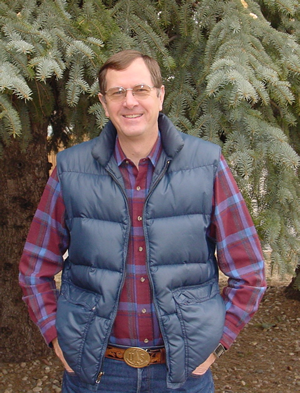Wayne D. Shepperd is a Research Silviculturist at the U.S. Forest Service Rocky Mountain Research Station in Fort Collins, Colorado. He holds a BS in Outdoor Recreation, and MS and Ph.D. degrees in Silviculture from Colorado State University. A Colorado native, Dr. Shepperd has been with the Forest Service since 1969 and will retire in January. He has authored or co-authored over 100 scientific publications and has conducted research on aspen since the 1970’s. He has outlasted most (but not all) of his contemporaries to become a recognized "aspen geezer.") So why is he standing in front of a blue spruce? More information about Wayne is available on his web site at http://www.fs.fed.us/rm/landscapes/Staff/Wayne.shtml |

|
The recently reported aspen die-off differs from normal aspen vegetative succession or decline in that mature trees die quickly within a year or two and no new sprouting occurs, indicating that the lateral roots may also be dead. If that is the case, then aspen will not re-occupy the site since the species reproduces primarily by root sprouting in the west. Die-off seems to begin in epicenters and spread radially through an affected aspen stand. Stands on all topographic positions, moisture regimes, and soil types are affected and the phenomenon has been reported throughout the west from Arizona into Alberta. Die-off can affect one aspen stand and leave other nearby stands untouched. Younger age classes and advanced regeneration are often not affected to the same extent as mature overstory trees in the same grove. Cytospora cankers, poplar borers, and other damage or stress agents are often associated with die-off epicenters; however the possibility of a yet-unknown invasive disease or insect cause still exists.
Aspen die-off has been reported for several years in Utah and Arizona, but only recently has become apparent in Colorado, where aerial surveys indicate thousands of acres are affected (new survey flights are presently being summarized and indicate additional areas have died this year). The apparent death of roots is disturbing, as aspen cannot sprout back if roots are dead (aspen rarely reproduces by seed and is nearly impossible to plant in the wild). Since this phenomenon has not been reported in the literature, we are unable to predict how long the die-back will persist, or how much area will be affected.
Recommended resourcesAn illustrated presentation (narrated PowerPoint) on aspen die-off can be viewed at: http://extension.usu.edu/forestry/utahforests/rtw2006/WayneShepperd.htm A good reference document on aspen ecology and management can be found at: http://www.fs.fed.us/rm/pubs/rmrs_gtr178.html An excellent aspen website is: http://www.aspensite.org/
|
